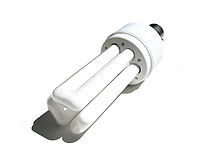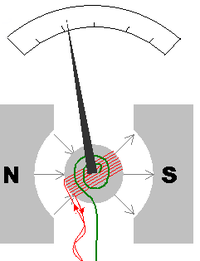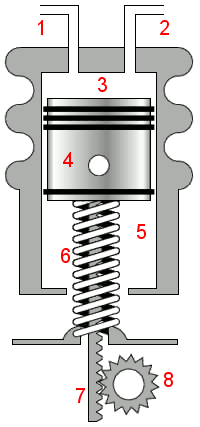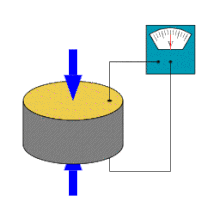Materials Science and Engineering/Diagrams/Transducers
A transducer is a device, usually electrical, electronic, electro-mechanical, electromagnetic, photonic, or photovoltaic that converts one type of energy to another for various purposes including measurement or information transfer (for example, pressure sensors). In a broader sense (for example in the Viable System Model) a transducer is sometimes defined as any device that converts a signal from one form to another.
Types of Transducers
[edit | edit source]Electromagnetic
[edit | edit source]Antenna
[edit | edit source]
An antenna is a transducer designed to transmit or receive electromagnetic waves. In other words, antennas convert electromagnetic waves into electrical currents and vice versa. Antennas are used in systems such as radio and television broadcasting, point-to-point radio communication, wireless LAN, radar, and space exploration. Antennas usually work in air or outer space, but can also be operated under water or even through soil and rock at certain frequencies for short distances.
Cathode Ray Tube
[edit | edit source]The cathode ray tube (CRT) is an evacuated glass envelope containing an electron gun (a source of electrons) and a fluorescent screen, usually with internal or external means to accelerate and deflect the electrons. When electrons strike the fluorescent screen, light is emitted.
The electron beam is deflected and modulated in a way which causes it to display an image on the screen. The image may represent electrical waveforms (oscilloscope), pictures (television, computer monitor), echoes of aircr
Fluorescent Lamp
[edit | edit source]
A fluorescent lamp or fluorescent tube is a gas-discharge lamp that uses electricity to excite mercury vapor in argon or neon gas, resulting in a plasma that produces short-wave ultraviolet light. This light then causes a phosphor to fluoresce, producing visible light.
Unlike incandescent lamps, fluorescent lamps always require a ballast to regulate the flow of power through the lamp. In common tube fixtures (typically 4 ft (122 cm) or 8 ft (244 cm) in length), the ballast is enclosed in the fixture. Compact fluorescent light bulbs may have a conventional ballast located in the fixture or they may have ballasts integrated in the bulbs, allowing them to be used in lampholders normally used for incandescent lamps.
Light Bulb
[edit | edit source]A lamp, in technical usage, is a replaceable component such as an incandescent light bulb, which is designed to produce light from electricity. These components usually have a base of ceramic, metal, glass or plastic, which makes an electrical connection in the socket of a light fixture. This connection may be made with a screw-thread base, two metal pins, 2 metal caps or a bayonet cap.
Magnetic Cartridge
[edit | edit source]
A magnetic cartridge is a transducer used for the playback of gramophone records on a turntable or phonograph. It converts mechanical vibrational energy from a stylus riding in a spiral record groove into an electrical signal that is subsequently amplified and then converted back to sound by a loudspeaker system.
Photodetector
[edit | edit source]Photosensors or photodetectors are sensors of light or other electromagnetic energy. There are several varieties:
Most optical detectors are quantum devices in which an individual photon produces a discrete effect.
- Chemical detectors, such as photographic plates, in which a silver halide molecule is split into an atom of metallic silver and a halogen atom. The photographic developer causes adjacent molecules to split similarly.
- Photoresistors or Light Dependent Resistors (LDR) which change resistance according to light intensity
- Photovoltaic cells or solar cells which produce a voltage and supply an electric current when illuminated
- Photodiodes which can operate in photovoltaic mode or photoconductive mode
- Photomultiplier tubes containing a photocathode which emits electrons when illuminated, the electrons are then amplified by a chain of dynodes.
- Phototubes containing a photocathode which emits electrons when illuminated and in general behaves as a photoresistor.
- Phototransistors incorporating one of the above sensing methods
- Optical detectors that are effectively thermometers, responding purely to the heating effect of the incoming radiation, such as pyroelectric detectors, Golay cells, thermocouples and thermistors, but the latter two are much less sensitive.
- Cryogenic detectors are sufficiently sensitive to measure the energy of single x-ray, visible and near infra-red photons (Enss 2005).
Photoresistor
[edit | edit source]
A photoresistor or LDR is an electronic component whose resistance decreases with increasing incident light intensity. It can also be referred to as a light-dependent resistor (LDR), photoconductor, or photocell.
A photoresistor is made of a high-resistance semiconductor. If light falling on the device is of high enough frequency, photons absorbed by the semiconductor give bound electrons enough energy to jump into the conduction band. The resulting free electron (and its hole partner) conduct electricity, thereby lowering resistance.
A photoelectric device can be either intrinsic or extrinsic. An intrinsic semiconductor has its own charge carriers and is not an efficient semiconductor, eg. silicon. In intrinsic devices, the only available electrons are in the valence band, and hence the photon must have enough energy to excite the electron across the entire bandgap. Extrinsic devices have impurities added, which have a ground state energy closer to the conduction band — since the electrons don't have as far to jump, lower energy photons (i.e. longer wavelengths and lower frequencies) are sufficient to trigger the device. If a sample of silicon has some of its atoms replaced by phosphorus atoms(impurities), there will be extra electrons available for conduction. This is an example of an extrinsic semiconductor.
Tape Head
[edit | edit source]A tape head is a type of transducer used in tape recorders to convert electrical signals to magnetic fluctuations and vice versa.
The electromagnetic arrangement of a tape head is generally similar for all types, though the physical design varies considerably depending on the application - for example video recorders use rotating heads which implement a helical scan, whereas most audio recorders have fixed heads. A head consists of a core of magnetic material arranged into a doughnut shape or toroid, into which a very narrow gap has been let (an air gap or other insulating material). This gap causes the magnetic flux to spill out of the material at that point, which is where the tape is made to run. The flux thus magnetises the tape at that point. A coil of wire wrapped around the core opposite the gap interfaces to the electrical side of the apparatus; thus either supplying a signal in the case of recording, or being fed to an amplifier in the case of playback. The basic head design is fully reversible - a variable magnetic field at the gap will induce an electric current in the coil, and an electric current in the coil will induce a magnetic field in the core and hence in the tape drawn across the gap.
Hall Effect Sensor
[edit | edit source]
A Hall effect sensor is a transducer that varies its output voltage in response to changes in magnetic field. Hall sensors are used for proximity switching, positioning, speed detection, and current sensing applications.
In its simplest form, the sensor operates as an analogue transducer, directly returning a voltage. With a known magnetic field, its distance from the Hall plate can be determined. Using groups of sensors, the relative position of the magnet can be deduced.
Electricity carried through a conductor will produce a magnetic field that varies with current, and a Hall sensor can be used to measure the current without interrupting the circuit. Typically, the sensor is integrated with a wound core or permanent magnet that surrounds the conductor to be measured.
Electrochemical
[edit | edit source]pH Probes
[edit | edit source]A pH meter is an electronic instrument used to measure the pH (acidity or basicity) of a liquid (though special probes are sometimes used to measure the pH of semi-solid substances). A typical pH meter consists of a special measuring probe (a glass electrode) connected to an electronic meter that measures and displays the pH reading.
Electro-Galvanic Fuel Cell
[edit | edit source]
An electro-galvanic fuel cell is an electrical device used to measure the concentration of oxygen gas in scuba diving and medical equipment.
A chemical reaction occurs in the fuel cell when the potassium hydroxide in the cell comes into contact with oxygen. This creates an electric current between the lead anode and the gold-plated cathode through a load resistance. The voltage produced is proportional to the concentration of oxygen present.
Electromechanical
[edit | edit source]Electroactive Polymers
[edit | edit source]Electroactive Polymers or EAPs are polymers whose shape is modified when a voltage is applied to them. They can be used as actuators or sensors. As actuators, they are characterized by the fact that they can undergo a large amount of deformation while sustaining large forces. Due to the similarities with biological tissues in terms of achievable stress and force, they are often called artificial muscles, and have the potential for application in the field of robotics, where large linear movement is often needed.
Galvanometer
[edit | edit source]
A galvanometer is a type of ammeter; an instrument for detecting and measuring electric current. It is an analog electromechanical transducer that produces a rotary deflection, through a limited arc, in response to electric current flowing through its coil. The term has expanded to include uses of the same mechanism in recording, positioning, and servomechanism equipment.
MEMS
[edit | edit source]Microelectromechanical systems (MEMS) is the technology of the very small, and merges at the nano-scale into nanoelectromechanical systems (NEMS) and Nanotechnology. MEMS are also referred to as micromachines (in Japan), or Micro Systems Technology - MST (in Europe). MEMS are separate and distinct from the hypothetical vision of Molecular nanotechnology or Molecular Electronics. MEMS generally range in size from a micrometer (a millionth of a meter) to a millimeter (thousandth of a meter). At these size scales, the standard constructs of classical physics do not always hold true. Due to MEMS' large surface area to volume ratio, surface effects such as electrostatics and wetting dominate volume effects such as inertia or thermal mass. Finite element analysis is an important part of MEMS design. The sensor technology made significant progress due to MEMS. Complexity and performance of advanced MEMS based sensors are described by different MEMS sensor generations.
Rotary and Linear Motor
[edit | edit source]
An electric motor uses electrical energy to produce mechanical energy. The reverse process, that of using mechanical energy to produce electrical energy, is accomplished by a generator or dynamo. Traction motors used on locomotives often perform both tasks if the locomotive is equipped with dynamic brakes. Electric motors are found in household appliances such as fans, refrigerators, washing machines, pool pumps, floor vacuums, and fan-forced ovens.
Vibration Powered Generator
[edit | edit source]Vibration powered generators are mechanisms for converting kinetic energy derived from ambient vibration to electrical energy. (See Transducer)
Potentiometer
[edit | edit source]A potentiometer is a variable tapped resistor that can be used as a voltage divider.
A form of potentiometer is used as an instrument to measure the potential (or voltage) in a circuit by tapping off a fraction of a known voltage from a resistive slide wire and comparing it with the unknown voltage by means of a galvanometer. The sliding tap of the potentiometer is adjusted and the galvanometer briefly connected to both the sliding tap and the unknown potential; the deflection of the galvanometer is observed and the sliding tap adjusted until the galvanometer no longer deflects. At that point the galvanometer is drawing no current from the unknown source, and the magnitude of voltage can be calculated from the position of the sliding contact. This null balance method is a fundamental technique of electrical metrology.
As an electrical component, potentiometer (or 'pot' for short) describes a three-terminal resistor with a sliding contact that forms an adjustable voltage divider. If all three terminals are used, it can act as a variable voltage divider. If only two terminals are used (one side and the wiper), it acts as a variable resistor or rheostat. Potentiometers are commonly used as controls for electrical devices such as a volume control of a radio. Potentiometers operated by a mechanism can be used as position transducers, for example, in a joystick.
Load Cell
[edit | edit source]A load cell is typically an electronic device (transducer) that is used to convert a force into an electrical signal. This conversion is indirect and happens in two stages. Through a mechanical arrangement, the force being sensed deforms a strain gauge. The strain gauge converts the deformation (strain) to electrical signals. Normally, a load cell consists of four strain gauges in a Wheatstone bridge configuration, but is also available with one or two strain gauges. The electrical signal output is normally in the order of a few millivolts and requires amplification by an instrumentation amplifier before it can be used. The output of the transducer is plugged into an algorithm to calculate the force applied to the transducer.
Accelerometer
[edit | edit source]An accelerometer is a device for measuring the total specific external force on the sensor. This is sometimes referred to as the acceleration but this is not strictly correct. A DC-coupled accelerometer sitting still on a table top has zero acceleration but will read a specific force equal in magnitude to the local acceleration due to earth's gravity at that location, which is nominally one g (earth's gravity varies slightly from location to location). This is because the table is imparting a reaction force on the accelerometer equal to the weight of the accelerometer. Since weight is mass multipled by the local gravitational accleration, the table must exert this much force on the accelerometer for it to stay still. When an acclerometer is falling a vacuum, there are no reaction forces on it. Thus when falling in a vacuum, the accelerometer will read zero. Accelerometers may be part of an Inertial Navigation System, used to detect and measure vibrations, or for measuring acceleration due to gravity (inclination). An accelerometer inherently measures its own motion (locomotion), in contrast to a device based on remote sensing.
Strain Gauge
[edit | edit source]
A strain gauge (alternatively: strain gage) is a device used to measure deformation (strain) of an object. Invented by Edward E. Simmons and Arthur C. Ruge in 1938, the most common type of strain gauge consists of an insulating flexible backing which supports a metallic foil pattern. The gauge is attached to the object by a suitable adhesive, such as cyanoacrylate. As the object is deformed, the foil is deformed, causing its electrical resistance to change. This resistance change, usually measured using a Wheatstone bridge, is related to the strain by the quantity known as the gauge factor.
String Potentiometer
[edit | edit source]A string potentiometer is a transducer used to detect and measure linear position and velocity using a flexible cable and spring-loaded spool. Other common names include "string pot", "cable-extension transducer", "draw wire sensor", and "yo-yo sensor".
Air Flow Sensor
[edit | edit source]Electroacoustic
[edit | edit source]Geophone
[edit | edit source]
The term geophone derives from the Greek word "geo" meaning "earth" and "phone" meaning "sound".
A geophone is a device which converts ground movement (displacement) into voltage, which may be recorded at a recording station. The deviation of this measured voltage from the base line is called the seismic response and is analysed for structure of the earth.
Gramophone Pick-Up
[edit | edit source]The phonograph, or gramophone, was the most common device for playing recorded sound from the 1870s through the 1980s.
Hydrophone
[edit | edit source]
A hydrophone is a microphone designed to be used underwater for recording or listening to underwater sound. Most hydrophones are based on a piezoelectric transducer that generates electricity when subjected to a pressure change. Such piezoelectric materials, or transducers can convert a sound signal into an electrical signal since sound is a pressure wave in fluids. Some transducers can also serve as a projector (emitter), but not all have this capability, and may be destroyed if used in such a manner.
Loudspeaker
[edit | edit source]
A loudspeaker, speaker, or speaker system is an electromechanical transducer that converts an electrical signal into sound. The term loudspeaker can refer to individual devices (otherwise known as drivers), or to complete systems consisting of an enclosure incorporating one or more drivers and additional electronics. Loudspeakers are the most variable elements in any audio system, and are responsible for marked audible differences between otherwise identical sound systems.
Microphone
[edit | edit source]
A microphone, sometimes referred to as a mike or mic, is an acoustic to electric transducer or sensor that converts sound into an electrical signal.
Microphones are used in many applications such as telephones, tape recorders, hearing aids, motion picture production, live and recorded audio engineering, in radio and television broadcasting and in computers for recording voice, VoIP, and for non-acoustic purposes such as ultrasonic checking.
Piezoelectric Crystal
[edit | edit source]
Piezoelectricity is the ability of some materials (notably crystals and certain ceramics) to generate an electric potential in response to applied mechanical stress. This may take the form of a separation of electric charge across the crystal lattice. If the material is not short-circuited, the applied charge induces a voltage across the material. The word is derived from the Greek piezein, which means to squeeze or press.
The piezoelectric effect is reversible in that materials exhibiting the direct piezoelectric effect (the production of electricity when stress is applied) also exhibit the converse piezoelectric effect (the production of stress and/or strain when an electric field is applied). For example, lead zirconate titanate crystals will exhibit a maximum shape change of about 0.1% of the original dimension.
Tactile Transducer
[edit | edit source]A tactile transducer or "bass shaker" is a device which is made on the principle that low bass frequencies can be felt as well as heard. A shaker transmits low-frequency vibrations into various surfaces so that they can be felt by people. This is called tactile sound. Tactile transducers may augment or in some cases substitute for a subwoofer.
A bass-shaker is meant to be firmly attached to some surface such as a seat, couch or floor. The shaker houses a small weight which is driven by a voice coil similar to those found in dynamic loudspeakers. The voice-coil is driven by a low-frequency audio signal from an amplifier; common shakers typically handle 25 to 50 watts of amplifier power. The voice coil exerts force on both the weight and the body of the shaker, with the latter forces being transmitted into the mounting surface.
Tactile transducers may be used in a home theater, a commercial movie theater, or for special effects in an arcade game, amusement park ride or other application.
